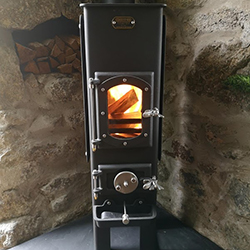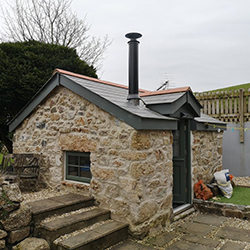The Environment & Stove Care

At Stove Care, we treasure the environment
We want to do our part to ensure that our beautiful forests and woodlands are preserved.
Wood burning stoves are one of the most cost-effective forms of renewable power that you can incorporate into your home. By 'renewable' we mean that wood used for fuel can easily be replaced by simply growing more - in fact wood experts tell us that if everyone switched to wood burners the UK could quickly become self-sufficient in wood fuel once our woods were properly managed and coppiced. Providing the wood fuel is harvested from a sustainable wood source then there is no net increase in CO2 emissions (the most significant greenhouse gas). At the moment in most woodlands wood is left to rot and is regarded as a waste material.
The Woodland Trust, the UK's leading woodland conservation charity, encourages the planting of trees for wood fuel and state: Using wood fuel to produce heat can be an excellent low carbon alternative to coal, oil and gas, but it depends on having a local, sustainable supply. The carbon released when wood is burned is effectively recaptured by growing replacement trees. This is much better than using fossil fuels, which add carbon dioxide to the atmosphere: using wood fuel avoids those extra emissions (www.woodlandtrust.org.uk). A well managed wood provides a diverse habitat for wild life and even a pile of wood left to season creates a home for insects which can then attract a variety of different birds.
Wood burning stoves are also very efficient. A high quality stove operating with efficiencies of up to 85% also loses very little heat through the flue and produces very little smoke pollution. Compare this to an inefficient open fire operating at around at 10%. The more inefficient then the more polluting it is. Although stoves are not quite as efficient at producing heat as a modern central heating boiler, they effectively have a zero carbon footprint, since any carbon dioxide produced by burning woodfuel is simply the same carbon dioxide which was absorbed by the tree when it was growing and you can't say that about a gas or oil boiler. A good wood burning stove is also between 20% to 30% more efficient than a typical gas fire or room heater which only operates at around the 60% efficiency mark.

Recommended Fuels
Why Use Wood?
Wood from sustainable sources is a renewable, environmentally friendly energy resource. It is considered carbon neutral, in that the CO2released during combustion balances the CO2 that was absorbed during its growth. As conventional energy prices continue to increase, the use of wood becomes more and more attractive.
What type of wood should I use?
Wood can be divided into two major classes, either hardwood or softwood. Hardwoods are typically slow growing deciduous broad leafed trees such as Beech, Ash and Oak. They have typically tightly packed annual growth rings reflecting the fact that they are slow growing.
Softwoods are typified as being fast growing evergreens or coniferous species such as Pine, Spruce and Fir. Their annual growth rings are usually bigger indicating faster growth.
Factors to Consider
Measured by weight, hardwoods and softwoods have similar energy contents of around 20MJ/kg (dry basis). However, hardwoods are typically twice as dense as softwoods and so, on a volume basis, you would require half the amount of hardwood to provide the same heat output as softwood. For this reason, hardwoods are preferred for burning. Softwoods are usually easier to light than hardwoods and are often used as kindling. Beech, Ash, Hornbeam and Cherry are considered to be the best hardwoods for stoves with Beech producing arguably the best flame pattern. The major concern in terms of combustion is however the wood’s moisture content. Freshly harvested wood can have water contents typically greater than 60% depending on the species and the time of year the tree was felled. Burning logs with this amount of water is not good for several reasons. As wood moisture content increases, so its useful energy content decreases, since energy is used up to drive off the excess moisture. At 60% moisture, wood can have an energy content of typically 6MJ/kg, but at 25% moisture this can increase to 14 MJ/kg. Trying to burn wet wood not only produces excess steam but can also contribute to excessive smoke caused by incomplete combustion. Unburned fuel can result in tar like deposits on the lining of the chimney so contributing to the risk of chimney fires. Prior to use on an appliance, it is therefore necessary to reduce the wood’s moisture content to acceptable levels using a process known as seasoning. The most effective way to do this is to cut the “as felled” trees into the required lengths for the stove and split these into logs typically 40 to 150mm diameter. These split logs should be stored for a period of time until their moisture content reduces to less than 25%. For natural seasoning, it is preferable to stack the logs under cover in an open sided store to allow a natural ventilation flow across them. The seasoning process can take up to two years or more depending on the tree species, when it was felled, and the drying conditions. It is also possible to buy logs that have had accelerated seasoning by being force dried in a kiln to the required moisture content.
Selecting the right log supplier
There are various factors which should influence the choice of supplier:-
- From an environmental standpoint it is preferable, where possible, to select a local supplier, as this reduces the energy required to transport the fuel.
- Does the wood supply come from a sustainable source?
- Has the wood been seasoned correctly?
- What type of wood is being supplied – hardwood, softwood or a mixture of both
- What is general size of the logs being supplied?
- It is preferable to buy logs by volume rather than weight as the influence of moisture content is removed.
The following should be avoided as combustion of these materials can give off unpleasant odours, and can also generate emissions that damage the environment and be harmful to health.
- varnished or plastic-coated wood
- wood treated with wood preservatives
- household waste
Recommended Fuels for Stoves
The solid mineral fuels listed below have been tested and approved by HETAS LTD on behalf of the fuel producer. The testing and approval combined with a quality assurance scheme enables the fuel to carry a HETAS approval logo for which the customer should look. Petroleum coke is not recommended by HETAS for use on solid fuel burning appliances because its use can result in serious damage to grates and other appliance components in the fuel bed area. However, a number of products which contain petroleum coke or are blends of petroleum coke with other fuels have been tested and approved. For these fuels approval is conditional on the manufacturer applying and maintaining stringent product control. Some appliance manufacturers restrict the use of these fuels to appliances with high chrome or chrome steel bottom grates, which may be supplied as an optional extra.
- Homefire Ovals - Available from Kuggar Stoves
- Homefire
- Phurnacite
- Ancit
- Taybrite
- Multiheat
- Briteheat
- Ecoal
- Maxibrite
- Briteflame
- Newflame
- Supacite
- Coalite
- Coalite Ovals
- Therma
- Cosycoke Briquettes
- Sunbrite Doubles - More than the usual amount of firelighters may be needed to ignite this product
- Cosycoke
- Pureheat
Natural Smokeless Fuels
- Onilywn Gp 1 Large/Small Nuts


